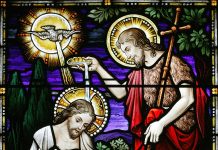
by Rev. Donald Senior, CP
See the Expanded Study Guide at the end of this article for additional Reflection Questions and Exercises.
In Verbum domini (the “Word of God”)—Pope Benedict XVI’s remarkable exhortation in response to the Synod on the Scriptures in the Life and Ministry of the Church—the Pope emphasizes the central role of the Bible in the catechetical ministry of the Church. It is not simply a matter of the content of the Scriptures informing the Church’s catechesis, but the profound impact that the Bible can have on the spirituality of the catechists themselves. As he notes, the Church’s catechesis “must be permeated by the mindset, the spirit and the outlook of the Bible and the Gospels…” (n. 74)
To make his point, the Pope recalls the beautiful story at the end of Luke’s Gospel in which the two disciples on the road to Emmaus have their sadness and disappointment transformed into joy as the Risen Christ himself, beginning with Moses and all the prophets, interprets the Scriptures for them. “Were not our hearts burning within us while he spoke to us on the way and opened the Scriptures to us?” (Luke 24:32). What catechist would not dream of having his or her students say the same as they look back upon what they had learned from their encounter with the Word of God?
To transmit to one’s students a love of the Scriptures is possible only when the catechist, too, has a deep love of the Bible and draws on the Scripture for his or her own spiritual nourishment and inspiration. The Church has often compared the Scriptures to the Eucharist itself. Just as we are nourished by the Body and Blood of Christ in the Eucharist, so, too, does the Word of God that comes to us in the Scriptures become like living bread that can fill our very being with new life.
How can one gain a deeper love of God’s Word? Drawing on Verbum domini and other sources of the Church’s collective wisdom, let me suggest a few ways.
A Habit of the Heart
First and foremost, anyone who wants to be steeped in the Scriptures and draw life from them has to develop a habit of actually reading the Bible. This does not mean we have to plow through the Bible from beginning to end—although that is not a bad idea! But we can make it a point to read more accessible passages on a frequent, if not daily, basis.
The Gospels, Paul’s letters, the stories of Genesis and Exodus, the writings of Isaiah and the prophets, the Psalms: These are fairly familiar ground for most of us. But what a difference it makes to read slowly, thoughtfully, prayerfully—on a regular basis—passages from these books of the Bible. Many Catholics use the daily readings in the Lectionary as their guide through the biblical world—each day sampling the texts that are heard at the Eucharist by millions of Christians around the world.
There are innumerable publications that provide attractive and inexpensive booklets that contain the daily readings and prayers of the Eucharist. Three good examples are Living with Christ (livingwithchrist.us), Give Us This Day (giveusthisday.org) and Magnificat (catholiccompany.com/magnificat); the latter two also offer daily prayers and reflections and an online format.
And, yes, there are several good apps with the Lectionary readings for those who want to put them on their iPads or smartphones.
Appreciating the Whole Story
The Bible, we know, is not a single, uniform book. Rather, it is a collection of books with a variety of literary forms composed over different periods of history and emerging from ancient cultures very different from our own. It is easy enough to get submerged in the details, and a lay person who has not had an opportunity for extended study of the Scriptures often may feel lost in the weeds.
While the prayerful reading of individual passages is at the heart of the matter, it is also important to keep the big picture in mind. The Bible as we now have it charts what we could call “the history of salvation.” This is the great saga of faith that frames the Scriptures and gives overall meaning to our world and its destiny. I sometimes think of the major components of that sacred history as humanity’s life cycle:
* Genesis tells the remote origins of our world and our ancestors, beginning with the creation stories and on into the drama of the patriarchs Abraham and Jacob and Moses.
* The Exodus stories take us to the moment of the birth of Israel, as it emerges from the slavery of Egypt and begins its life journey toward freedom.
* The Desert Wandering that we read about in the books of Exodus, Leviticus, and Deuteronomy is a strange and important interlude in the biblical saga, not unlike the turbulent and formative time of one’s adolescence. There is rebellion and experimentation during this testing period, but it is also a time when Israel is formed as God’s people and given the covenant with God.
* We can think of the period recounted in books like Joshua, Judges, Samuel, Kings, and Chronicles as the “maturation” of Israel—its middle age, if you like—when it took possession of its land and ultimately built the monarchy and its social institutions.
* But, strangely, it was right at this moment of its greatest strength that Israel began to lose its way, and its founding ideals were forgotten and violated. There then comes that part of the Bible when the disturbing and challenging voices of the prophets—Amos, Hosea, Isaiah, Jeremiah, and so on—are heard, calling Israel back to its defining values and allegiance with God.
* And then all seems lost and diminished for Israel as it experiences deportation and exile—not unlike the period of aging in the human life cycle, when many of the things we counted on seem to break down. So many of the Psalms and part of the prophetic books lament Israel’s loss and cry out for God’s help.
* And that brings the story of Israel to a new moment, one of greater serenity and peace—as it returns to its homeland and no longer puts its trust in mere human institutions but longs for God to come and redeem Israel. Here the books of Ezra and Nehemiah, parts of Ezekiel, and later biblical books speak about the hopes of Israel for God’s coming reign.
From the viewpoint of Christian faith, the decisive chapter of this story is found in the New Testament, where the Word of God that has coursed throughout Israel’s history now becomes flesh in the person and mission of Jesus Christ. Jesus, the one sent by the Father, brings the fullness of life and hope to our world.
The story of Jesus and the reflections upon his death and Resurrection that are the focus of the New Testament writings do not negate or render obsolete the Old Testament writings. Rather, for the Christian reader of the Bible, the story of Israel takes on new meaning and coherence in the light of Christ.
Reading the Scriptures from this overall vantage point helps us keep track of how each individual component of the Bible fits into the story of salvation. And that story of salvation should also be deep in the consciousness and life story of the one entrusted with teaching the gospel to others.
The Scriptures as Mirror
Some interpreters of the Bible have suggested that we can approach the Scriptures either as a “window” or a “mirror.” Reading the Bible as a “window” means that our interest is primarily in the history and context that lies behind a particular biblical story or passage: e.g., What really happened in the crossing of the Red Sea and where was the original Mt. Sinai located? Or how many gallons did those stone jars hold at the wedding feast of Cana and who were the Sadducees?
While such historical and contextual questions are legitimate and important, the approach we are talking about here is more like reading the Scriptures as if they are a “mirror”—that is, the focus is on the relationship between the biblical text and the life of the reader. What does this biblical passage mean for me—or for us? How does my experience or our experiences relate to the biblical passage? How does one illumine the other?
Most people of faith turn to the Scriptures with this kind of interest in mind. When Moses tells the people of Israel that they should be attentive to the needs of the widow, the orphan, and the sojourner (see Deuteronomy 10:18), what does that mean for me today? When Jesus tells Peter to forgive seven times seventy times (see Matthew 18:22), what light does that throw on my struggles with my spouse or my children?
Here is where a habit of prayerfully reading the Bible can work its way deeply into our life. Sometimes the words and images and stories of the Bible give us the right words or images to understand and express our experience. For example, God’s verdict in the creation story of Genesis 1 about the intrinsic goodness of the world he created expresses our commitment to respect the environment. Jesus’ anguished words from the cross—“My God, my God, why have you forsaken me?” (Mark 15:34; Matthew 27:46)—enable us to express our anguish and confusion at times of deep suffering. Jesus’ reassuring words to his disciples—“Do not let your hearts be troubled…I am going to prepare a place for you…” (John 14:1, 2)—have brought comfort to those who mourn the loss of loved ones at countless funerals. The parables of the Rich Man and Lazarus or the Publican and the Sinner have made indelible marks on our literature and often come to mind to guide us through moral dilemmas. The gospel stories of Jesus’ calling his first disciples and sending them out on mission have forged the language of Christian vocation throughout the centuries. Such examples could be multiplied without end.
Heart and Head
Illuminating our lives and our experiences with the words and images of the Scriptures is, indeed, a habit of the Christian heart. We need our heads, too! Interpretation of the Bible is not a matter of a personal whim; over time, all of us need the wisdom of the Church’s teaching and the good sense of other Christians to help us keep on an even keel. Yet, the incredibly rich and beautiful metaphors, images, and stories of the Bible belong to us and—like exquisite poetry or great literature—can help us find the right words to express our deepest longings and strongest hopes.
Making frequent and prayerful reading and study of Scripture a habit of the heart; keeping in mind the overall biblical story as the framework for understanding particular books or passage of the Bible; and allowing the Scriptures to illumine our own experience and thereby finding in the Scriptures the words and images for our deepest human longings: These are some of the ways we, too, might feel our hearts burning within us on our journey of faith.
Rev. Donald Senior, CP, is President of Catholic Theological Union in Chicago, where he is also Professor of New Testament. He is a frequent lecturer, has served on numerous boards and commissions, and is widely published. Father Senior is past President of the Catholic Biblical Association of America and of the Association of Theological Schools of the United States and Canada. He currently serves as the President of the Council of Religious Leaders of Metropolitan Chicago. In 2001, Pope John Paul II appointed him as a member of the Pontifical Biblical Commission, and he was reappointed in 2006 by Pope Benedict XVI.
Expanded Study Guide
Father Donald Senior, a leading Catholic biblical scholar, introduces us to the beautiful Vatican document Verbum domini resulting from the Synod on the Scriptures in the Life and Ministry of the Church (2010). The Scriptures need to be central to a catechist’s life. In his apostolic letter Porta fidei, Pope Benedict XVI wrote: “We must rediscover a taste for feeding ourselves on the word of God…” (n. 3). Father Senior encourages us to make a habit of frequent and prayerful reading and studying of the Scriptures. The Scriptures are a portal for the “door of faith.” Faith “is the lifelong companion that makes it possible to perceive, ever anew, the marvels that God works for us” (Congregation for the Doctrine of the Faith. “Pastoral Recommendations for the Year of Faith,” 2012).
In this article, Fr. Senior focuses on striving to ignite a refreshed love of Scriptures by discovering how to authentically pray the Scriptures into our lives.
Reflection Questions
1. Do I bring the Scriptures to life every day? If not, what are the challenges I face? (Be specific.)
2. How often is my heart burning within me when I prayerfully engage the Scriptures, either for strengthening my spiritual life or awakening a love for the Word of God in the lives of my students?
3. How do I understand Fr. Senior’s comparison of the Scriptures to the Eucharist? What new perspective does this idea bring to my praying the Scriptures? For receiving the Eucharist?
4. What do I understand as “a habit of the heart” as it relates to Scripture? How can I make this a reality in my prayer life?
5. What is the “big picture” to which Fr. Senior refers? How might this idea help me deepen my love for and praying with the Scriptures?
6. What are some of the great sagas of faith that frame the Scriptures according to Fr. Senior? What do I currently know about these great sagas? What might I do to delve more deeply into them? Do I see parallels to these biblical sagas in my own life? What might they mean for me?
7. What does Fr. Senior mean when he states: “We can approach the Scriptures either as a ‘window’ or a ‘mirror’”?
8. What recommendation does Fr. Senior offer me for bringing the Scriptures alive in my life? What steps will I embrace to reinvigorate praying the Scriptures to intensify my faith?
Exercises
1. To deepen your appreciation of Scriptures, read Blessed John Paul II’s apostolic letter Verbum domini. What new insights do you receive that may help you rediscover a love for the Scriptures or help you stimulate a love for the Scriptures in your students?
2. Read the Emmaus story to your students (Luke 24:13- 35). Invite your students to role-play the account or illustrate the story through an art form and present it to a younger group of students. How does engaging in this story arouse a deeper desire to want to come to know Jesus more intimately?
3. Make a conscious effort in class each week to prepare your students to hear and pray the Sunday’s Scripture readings. Prepare a handout that the family might use to prepare them to hear the Scriptures proclaimed, including activities following Mass that enable them to discuss what they heard and how it might apply to their family life during the week.
4. In 1998, St. John’s Abbey and University commissioned renowned calligraphy Donald Jackson to produce a hand-written, illuminated Bible for today. It is one of the great wonders of the twenty-first century, guiding people toward a new love for the Scriptures. Search out both YouTube and Google for St. John’s Bible for a wealth of narrative accounts, images, and more concerning this Bible. Design a project with your students for discovering how the St. John’s Bible Project can aid in deepening our appreciation of the Scriptures. Or, using St. Mark’s Gospel, have your students design an illuminated version of various passages of the Scriptures. Incorporate their art in prayer services in the classroom.
5. Teach your students how to practice lectio divina in their life. Develop simple guidelines that speak directly to your students. Practice lectio divina in your classroom.
Additional Resources
Catechism of the Catholic Church. Washington, DC: USCCB Publishing, 1994 (usccb.org).
Congregation for the Doctrine of the Faith: Recommendations for the Year of Faith (vatican.va).
Disciples Called to Witness: The New Evangelization. Committee on Evangelization and Catechesis. Washington, DC: USCCB Publishing, 2012 (usccb.org).
Porta fidei (The Apostolic Letter for the Indiction of the Year of Faith). Benedict XVI. Vatican City, 2011 (vatican.va).
United States Catholic Catechism for Adults. Washington, DC: USCCB Publishing, 2006 (usccb.org).
Copyright 2013, Bayard, Inc. All rights reserved. This article is protected by United States copyright and other intellectual property laws and may not be reproduced, rewritten, distributed, redisseminated, transmitted, displayed, published or broadcast, directly or indirectly, in any medium without the prior written permission of Bayard, Inc.



